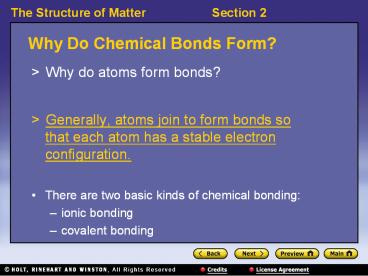Why Do Chemical Bonds Form? - PowerPoint PPT Presentation
1 / 8
Title:
Why Do Chemical Bonds Form?
Description:
Why Do Chemical Bonds Form? Why do atoms form bonds? Generally, atoms join to form bonds so that each atom has a stable electron configuration. There are two basic ... – PowerPoint PPT presentation
Number of Views:167
Avg rating:3.0/5.0
Title: Why Do Chemical Bonds Form?
1
Why Do Chemical Bonds Form?
- Why do atoms form bonds?
- Generally, atoms join to form bonds so that each
atom has a stable electron configuration. - There are two basic kinds of chemical bonding
- ionic bonding
- covalent bonding
2
Comparing Ionic and Covalent Bonds
3
Ionic Bonds
- How do ionic bonds form?
- Ionic bonds form from the attractions between
oppositely charged ions. - ionic bonds the attractive force between
oppositely charged ions, which form when
electrons are transferred from one atom to another
4
Ionic Bonds, continued
- Ionic bonds are formed by the transfer of
electrons. - Two atoms tend to form an ionic bond when one
atom has more attraction for electrons than the
other.
5
Covalent Bonds
- What do atoms joined by covalent bonds share?
- Atoms joined by covalent bonds share electrons.
- covalent bond a bond formed when atoms share one
or more pairs of electrons. - Compounds that are networks of bonded atoms, such
as silicon dioxide, are also covalently bonded. - Covalent bonds usually form between nonmetal
atoms.
6
Covalent Bonds, continued
- Atoms do not always share electrons equally.
- nonpolar covalent bonds bonds in which electrons
are shared equally - When two atoms of different elements share
electrons, the electrons are not shared equally. - polar covalent bond a bond in which there is an
unequal sharing of electrons. - Electrons tend to be more attracted to atoms of
elements that are located farther to the right
and closer to the top of the periodic table.
7
Metallic Bonds
- What gives metals their distinctive properties?
- Metals are flexible and conduct electric current
well because their atoms and electrons can move
freely throughout a metals packed structure. - metallic bond a bond formed by the attraction
between positively charged metal ions and the
electrons around them
8
Polyatomic Ions
- How are polyatomic ions similar to other ions?
- A polyatomic ion acts as a single unit in a
compound, just as ions that consist of a single
atom do. - polyatomic ion an ion made of two or more atoms































